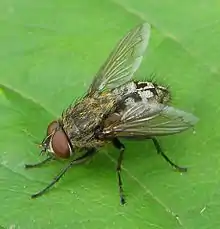Cluster fly
The grass flies or cluster flies or attic flies are the genus Pollenia in the family Polleniidae are completely harmless to human health. They are strictly parasitic on earthworms; the females lay their eggs near earthworm burrows, and the larvae then feed on the worms. Cluster flies seek refuge in cold weather and find their way into attic spaces and similar areas indoors. They often emerge on warm days, and cluster at windows attempting to exit(hence the name).
| Cluster fly | |
|---|---|
 | |
| Male Pollenia sp. | |
| Scientific classification | |
| Kingdom: | Animalia |
| Phylum: | Arthropoda |
| Class: | Insecta |
| Order: | Diptera |
| Subsection: | Calyptratae |
| Superfamily: | Oestroidea |
| Family: | Polleniidae |
| Genus: | Pollenia Robineau-Desvoidy, 1830[1] |
| Type species | |
| Musca rudis[2] Fabricius, 1794 | |
| Synonyms | |
| |
The typical grass fly Pollenia rudis is about 7 mm long and can be recognised by distinct lines or stripes behind the head, short golden-coloured hairs on the thorax, and irregular light and dark gray areas on the abdomen. Cluster flies are typically slow-moving.
Cluster flies have a widespread distribution. Eight species are found in Britain and 31 in Europe. Pollenia species are also numerous in Australia and New Zealand (over 30 species); they are common in North America. P. rudis has spread widely in association with humans.
Species
- P. amentaria (Scopoli 1763)
- P. angustigena Wainwright 1940
- P. atramentaria (Meigen 1826)[4]
- P. bezziana Rognes 1992
- P. bicolor Robineau-Desvoidy 1830[1]
- P. bulgarica Jacentkovsky 1939
- P. contempta Robineau-Desvoidy 1863
- P. dasypoda Portschinsky 1881
- P. fulvipalpis Macquart 1835
- P. griseotomentosa (Jacentkovsky 1944)
- P. hungarica Rognes 1987
- P. labialis Robineau-Desvoidy 1863
- P. leclercqiana (Lehrer 1978)
- P. luteovillosa Rognes 1987
- P. mayeri Jacentkovsky 1941
- P. mediterranea Grunin 1966
- P. moravica (Jacentkovsky 1941)
- P. paupera Róndani 1862
- P. pectinata Grunin 1966
- P. pediculata Macquart 1834
- P. ponti Rognes 1991
- P. pseudintermedia Rognes 1987
- P. pseudorudis Rognes, 1985
- P. rudis (Fabricius 1794)
- P. ruficrura Róndani 1862
- P. similis (Jacentkovsky 1941)
- P. tenuiforceps Róndani 1928
- P. vagabunda (Meigen 1826)[4]
- P. venturii Zumpt 1956
- P. vera Jacentkovsky 1936
- P. verneri Rognes 1992
- P. viatica Robineau-Desvoidy 1830[1][5]
References
- Robineau-Desvoidy, André Jean Baptiste (1830). "Essai sur les myodaires". Mémoires presentés a L'Institut des Sciences, Lettres et Arts, par divers savants èt lus dans ses assemblées : Sciences, Mathématiques et Physique. 2 (2): 1–813. Retrieved 15 July 2018.
- Sabrosky, Curtis W. (1999). "Family-Group Names in Diptera An annotated catalog" (PDF). MYIA, The International Journal of the North American Dipterists' Society. Leidan: Backhuys Publishers. 10. Archived from the original (PDF) on 11 April 2008. Retrieved 31 May 2008.
- Gisondi S, Rognes K, Badano D, Pape T, Cerretti P (2020) The world Polleniidae (Diptera, Oestroidea): key to genera and checklist of species. ZooKeys 971: 105–155. https://doi.org/10.3897/zookeys.971.51283
- Meigen, J.W. (1826). Systematische Beschreibung der bekannten europäische n zweiflugeligen Insekten. Hamm: Vierter Theil. Schulz-Wundermann. pp. xii + 412 pp., pls. 42-54.
- Rognes, Dr Knut; Pape, Dr Thomas (19 April 2007). "Taxon details: Calliphoridae". Fauna Europaea version 1.1. Retrieved 31 May 2008.
External links
| Wikimedia Commons has media related to Pollenia. |
- Images of some cluster fly species: Pollenia amentaria Scopoli ; Pollenia angustigena Wainwright and Pollenia rudisFabricius.
- European including Russia species